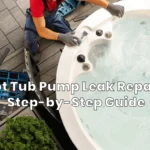If your do-it-yourself fixes fail to fix the problem or your system is more than 10 years old, you might want to have a professional consider an assessment or replacement of your system. Plan ahead and you can enjoy efficient running of both your water and heating economically all year round.
My friends, let us jump in and explain why the hot tub is heating slowly and more importantly how we can repair it quickly. Whether it is routine heating times or right on the frontlines of troubleshooting the most typical issues, we will have you hot in a hurry.
How to Make a Hot Tub Heats Up Quickly?
The average warm bath is typically warmed at 3 to 6 C an hour (5 to 10 F an hour) of hot water. This could take different ranges of time between 3 to 8 hours depending on the number of insulation and size of the hot tub and model on how it can be completely heated. In the cold climate it might take up to 12 hours.
Heat-up time affecting factors:
- Ambient Temperature:As the air becomes colder it warms up at a slower rate.
- Tub Size and Volume: The bigger the hot tub, the longer it will take to heat.
- Heater Power: The most common domestic heaters are 1.5kW to 5.5kW.
- Insulation Quality: The more the insulation the less heat loss.
The most Common Causes of Your Hot Tub Heating Slowly
Filters that are Dirty or Clogged
Slow moving water: Filters clogged or dirty filters slow down water. It makes it highly difficult to pass water through the heater.
Fix: Unscrew and wash the filter. Soak overnight in a filter cleaner solution to clean more fully. Replace it, if it is older than one year.
Problems with circulation or pump
Water is pumped through the heating element with the hot tub pump. When it is not heating due to a broken impeller, shut valves, or low power, then you might have water that is not heating.
Fix: Listen out to strange sounds. Be sure to open valves, and verify whether the impeller spins without any hitch.
Airlock in the System
Stagnant air trapped in the plumbing pipes can cause the water not to move freely and even prevent the heating.
Fix: Unscrew the pump union a little to allow air which is trapped to escape. Then pump on once more.
Water flow/ pressure switch problems
A pressure switch or a flow sensor will be added to most hot tubs, and this will be used to shut off the heater when there is improper movement of the water. This sensor can be triggered by clogged plumbing, a lack of water or jets that are blocked.
Fix: Position the water so that it is higher than the jets. Clean the drainage and look at clogs.
Heating Element or Thermostat Issues
warm water or that it is going cold and then hot, then most probably your thermostat has gone wrong or your heating element has burnt up.
Fix: Test electrical continuity with a multimeter. Replace the defective component, in case of necessity.
SaluSpa & Inflatable Hot Tub heating issues
Inflatable tubs like SaluSpa tend to be slow in heating relative to ordinary tubs. The issues which people refer to include:
- SaluSpa does not overheat to 95/100 degree Fahrenheit.
- Overnight stalls heat
Causes:
- Economy mode/sleep mode enabled
- The insufficient insulation or thin covers
- Leaving things in the cold places
Fix Tips:
- See if you can get some kind of thermal cover, or perhaps floating thermal blanket.
- Put some foam mats underneath the tub so that less heat can get lost into the ground.
- To retain more heat, turn off the jets when heating, should you desire to do so.
Have Your Hot Tub Heat Up Faster?
Insulated Cover: This cover keeps the heat and accelerates the heating process.
Add a Floating Thermal Blanket: It lies on the surface of water and reduces the loss of heat.
Pre-Heat During the Day: Warmth of the air reduces the time of the heat.
Change to Standard Heating Mode: Do not use economy/sleep modes.
Heat Up, Keep Jets Close: Lessens the cooling of the water by air.
Preventative Maintenance Suggestions
Periodic servicing ensures that a hot tub is in good condition and is heating up to the desired degree. These fundamentals are worth a look:
- Change filters each week
- Inspect water level prior to use
- Check the pump twice a year
- Clean sewer pipes, every three months
- Every 3-4 months drain and refill
How to Know When it is Time to Replace the Hot Tub Heater?
Hot tub heaters do not last forever even when you take good care of them.
- Normal heater life: 5-7 years
- Indicators of failure:
- Blowing circuit breaker
- Water that fails to attain set temperature
- Corrosion or abrasion
- Very loud buzzing or popping noises
Remedy: You could consider contacting a qualified technician so that you can have it checked. Replacing it, maybe, in case of necessity.
Last Quick Fix Checklist
A quick way to heat up would be as follows:
- Service the filters
- Inspect pump and impeller
- Bleed airlocks
- Fill up the water levels
- Wear a thermal cover
- Turn off sleep/economy features
- Warmth in the hottest time of the day
Conclusion: Don’t Wait to Heat so Your Soak is Spoiled
The case of slow hot tub heating is not a problem that should be permanent. With a little bit of troubleshooting, maintenance and equipment the hot tub could be brought back to its finest. Dusty filters, airlocks, perhaps your heater replacements can take forever to heat up your hot tub, the guide below will provide you all the knowledge you need to have quick heating of your hot tub.
Suppose you have a top of the range spa or an inflatable SaluSpa, then by using the above tips, you can keep the heat in: it will be there and waiting when you require it.







